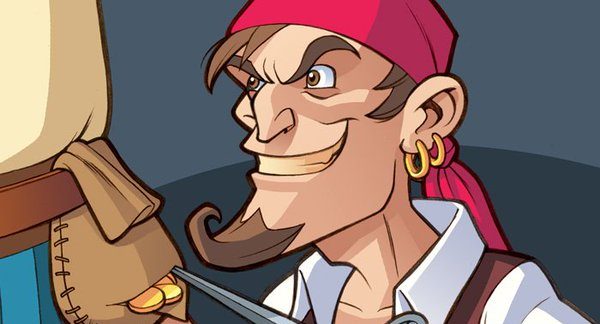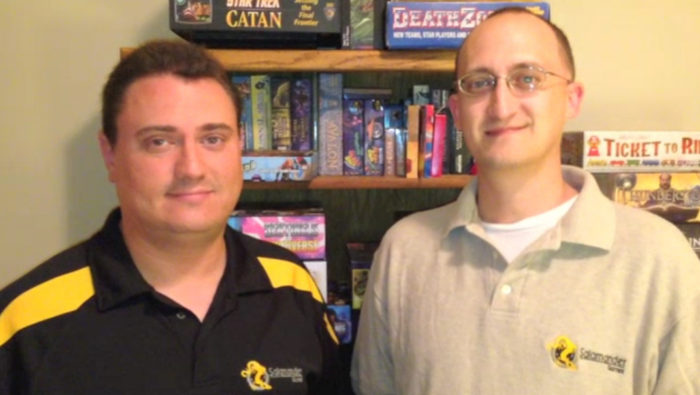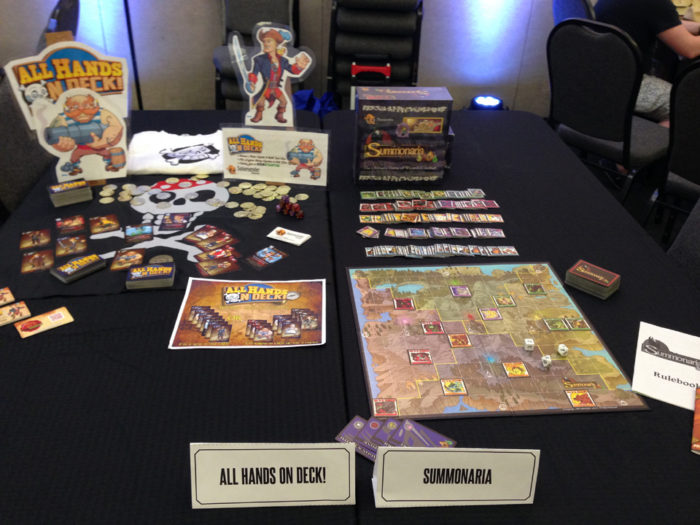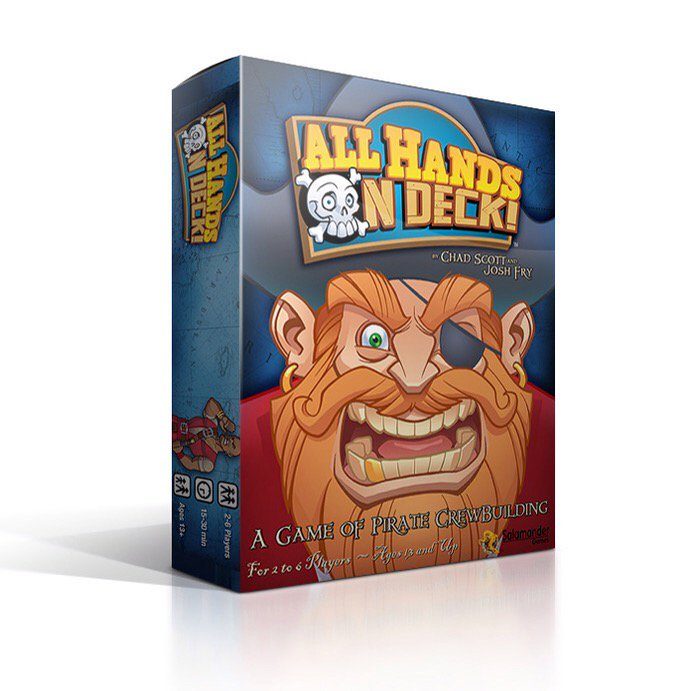Your cart is currently empty!
Guest Post: Chasing Your Passion

We like to promote local designers. Here’s a fantastic post from local designer Josh Fry of Salamander Games on his journey to become a game designer and publisher.
Greetings friends and fellow gamers!
I am so excited to see our board gaming community grow and get more organized in this last year. When the Oklahoma Board Game Community reached out to our group looking for people willing to do content submissions, I just had to respond and ask if I could be a part of it. Board gaming has been my passion since I was a kid and I jump at the chance to talk about it with anyone. It truly is the best hobby in the world!
Tabletop gaming is more to me than just a pleasant diversion from the stresses of work and family life, it is also my second career. Together with my cousin and best friend Chad Scott, we decided to turn our interest into an endeavor and formed Salamander Games, a design and publishing company based right here in Oklahoma City.
But why does someone decide to get into the creation side of hobby gaming?
It seems like the smart play is to stay on the consumer side, play all the games you can, as much as you can, and enjoy every minute of it. Well some see it as a natural progression, something like “I have played all these games, now I want to make something new!” Some think there is big money to be made (Spoiler: If you want big money, become an Actuary.)

It began about 16 years ago for us as a conversation about wanting to do something creative that we were passionate about. We were both career professionals in the IT industry and while that can be a stable job, it is anything but creative. We had been lifelong gamers from the very first consoles to computer games, roleplaying games and board games of all types and varieties.
I think it was the RPG exposure we had early on that first gave me a taste for creating a game experience for someone else. Being a GM and creating adventures was a lot of work, but it was so much fun. We talked about how much fun it would be to try designing something, and being entrepreneurial by nature, the possibility of taking it to market seemed like a fun idea. So we seriously considered designing games and where that might take us.
Armed with our plan of attack, we jumped boldly off the ledge. At the time there were three of us involved, and we thought that a good number for creating ideas and having enough feedback from inside the team to cultivate ideas with promise. We set up our business and agreed to throw a little money at it to pay for what we needed.
We enthusiastically started working on several ideas. Back in those days before kids and responsibilities, it was easy to jump into it in the evenings and spitball ideas, try new things out and completely retool elements that weren’t working. Keep in mind this was back before there was much information on how to do any of this out there!
BoardGameGeek had just launched and wasn’t really even on our radar. Social media wasn’t even a concept and there weren’t many websites out there speaking the mantra of the aspiring game designer. While we had the sense to try and see how others were doing it, it was extremely hard to see through the veil. The attitude at the time seemed much more in line with the notion of “You can’t see what we are doing, you might steal our ideas!”
Reaching out to other small designers who had published games proved difficult because of how hard it was to find their contact information. In such a resource-poor environment, we were faced with the challenge to find out what we could, make some assumptions and move forward with whatever approach seemed the most valid at the time.
After fleshing out a number of ideas, we struck on one. We previously worked on a larger game concept that required miniatures and a lot of components. While we liked the concept, we recognized that such a large game would eat our proverbial lunch if we tried to self-publish it.
I have to admit that at the time, there wasn’t much documentation about designers submitting their designs to existing game publishers and we assumed (probably VERY incorrectly) that a lot of those companies published internally designed games only. Publishers didn’t have a big presence at any of the small cons we attended and from the outside looking in, it seemed like the only way for us to see our work come to life was self-publishing.
We recognized that the need to constrain our first foray into publishing, so we opted to put our simpler design at the front of the line and see where we could go with it; thus Summonaria was born. We fleshed it out, played it, replayed it, played it some more, got friends to play it, tweaked the theme, made those friends play it more, got tired of playing it, balanced the units using statistics and played it even more.

This was the a-ha moment for me where I realized that the reality of becoming a game designer was that I had to be willing to shift from playing lots of different games because I want to, into playing my own game until I was tired of it because I HAD to.
It does require a tremendous amount of persistence to work on a concept until it feels solid.
While it can be fun, it can also be quite a bit of work. We lost our third partner during this process and questioned whether we should continue, but at this point felt the momentum pulling us forward. We were getting some great feedback from our playtesting team (small though it was) and felt Summonaria had the potential to be something many people would enjoy. We got an illustrator involved and worked out the components. As the art began to come in piece by piece, we began to see the project take on a whole new and exciting feel.
We struggled through graphic design, layout, color choices and font types. We made prototype after prototype and tried to figure out from our small inner circle of players what worked and what didn’t. We finally felt like we had gotten this game to a great place and now had to figure out where do we go from here?
We eventually turned our attention to the concept of self-publishing. I had found some information from a handful of others who had done it and used what little could be gleaned to chase down a number of printers.
What followed was a flurry of production quotes, discussions about material types, shipping, warehousing, budgets… you know, the FUN part of gaming.
As both of us had an educational background in industrial engineering and an interest in product development, we gladly took on these challenges, but we were deep in unknown territory! Ultimately, we figured out a plan for getting our game printed, figured out how we would self-fund this thing (with a huge help from supportive family members that we are endlessly thankful for) and got the whole ball of wax moving forward.
The day came when the UPS truck showed up with the first 17 cases of our brand new game. Let me tell you, breaking the seal on that first box was one of the top five best feelings I’ve ever experienced in my life.
To see something I created, labored over, poured all of myself into actually there in full color and cardboard glory gave me a true sense of accomplishment.
From there we found a whole new mountain to climb, that of marketing, distribution, promotion and sales. We had a couple thousand copies of this game (Designer’s note: That’s WAY too many for your first game!), so we had to figure out how to make people aware it was out there and get them to try it.
We spent the next several years tilting at that windmill and trying to find a way into the silver spire that was game distribution. There didn’t seem to be a ready way to break into the flow of products into the game stores.
During this time, life happened.
We went through periods where we ramped up and then slowed down. There were marriages and moves, kids and job changes always tugging at me to lay the pursuit down and do other things. Fortunately there was two of us to provide an anchor to this dream. Had it been just one of us, it would have been shelved.
I think that’s the real challenge of the aspiring game designer, recognizing that it is a passion project. We had to make it fit inside the boundaries of the time left after work, family and everything else have already taken their piece. We made time for it by giving up other pursuits.
It was easy to set it aside and concentrate on the day to day and then look up and realize nothing had been done. Once, four months passed by. I had to be purposeful with it to make progress and Chad kept me on task helped immensely. Thanks buddy!
Over the next several years we found some traction. As the tabletop gaming community grew around us, there were more opportunities to reach out and get connected with other gamers, show off what we were doing and find out how others were dealing with the same challenges. We ultimately got Summonaria into distribution and received some sales. Marketing with a non-existent budget is frustrating, but we were happy to see our game finally sitting on a store shelf.
We also started working on other ideas, slowly developing them and modifying them with the experience we gained from getting our first game to market. We played more games and researched endlessly about the industry, trying to learn from our missteps.
We opted to work on smaller, more approachable designs to limit our costs and create a lower barrier to market entry. We tweaked and tuned an old idea into something we began to get a lot of positive response about. So we decided to give Kickstarter a try, hoping it would give us a sense for the potential interest before we invested a ton of money into production. It also gave us a good vehicle for direct visibility to interested gamers.
In September of 2014, we launched our All Hands on Deck! campaign, and had great response but didn’t quite make our goal. We went back to the drawing board, came up with solutions to get our pledge costs down, offered additional rewards, and returned with a successful campaign last November.
We are now hard at work wrapping everything up to get it off to the printer and looking forward to the next project and what that looks like. After a long, and at times difficult road, things are looking promising for Salamander Games and I’m very excited at what the future has in store. I have met some great people through the Oklahoma Board Game Community and I hope I can get to know even more of you all in the coming year. Now let’s get out there and play some games!
You can learn more about Salamander Games here. Follow them on Twitter: @PlaySalamander.

